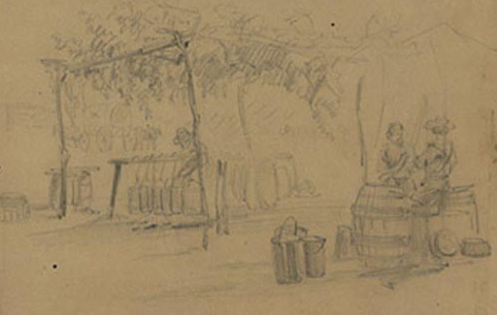Food, being one of the necessities for life, a major part of human culture, and a determining factor for the success of various civilizations can be overlooked, misused, and underutilized in periods of the history of the United States. Although food may be not be given enough credit for general success in America, in the early United States, 1775-1865, the development and use of methods that pertained to food rations, preservation of food, and cooking of food increased the power of the military forces, because of the increased wellbeing, nourishment, and the prevention and spread of diseases, most commonly scurvy, amongst soldiers.
In the late 18th century, the health and wellbeing of soldiers were considered more after the observation of higher rates of mortality caused by sickness rather than combat[1]. One of these first considerations came from Benjamin Rush, an American physician, and mental health advocate. Both of these titles are among his many contributions to culture and politics in early America. He concluded that there are five necessities to preserving health amongst the soldiers. Those being from most needed to least: dress, diet, cleanliness, encampments, and exercise[2]. The idea of a set ration in the military came from the necessity of diet which Rush took a large inspiration from Caesar and his rations for the Roman Army. Rush’s suggested ration revolved around vegetables as the main source of substance over meat due to meat’s unhealthy effects and induced drowsiness on the body[3]. Rush also took Caesar’s choice of wheat over flour into consideration, because of flour’s ability to be damaged easily or rendered useless nutritiously when not cooked properly[4]. Although an unpopular opinion amongst soldiers Rush believed that alcohol of any kind had no place in the army unless the use of it was after intense physical duty or in small quantities and diluted with a ratio greatly in favor of water[5]. Rush also implemented the idea of carrying flasks of vinegar to prevent illness and decrease putrefaction amongst soldiers[6], but not all his suggestions made it into the set ration.
Rush’s idea of a set ration had become widely known enough to influence George Washington, whose order’s to Congress proceeded to set a ration consisting of: one pound of beef or salted fish or three fourths of a pound of pork each day, one pound of bread or flour each day, 3 pints of peas or beans each week or vegetables equal to the cost of peas or beans, one pint of milk each week, half a pint of rice or one pint of cornmeal each week, one quart of spruce beer or cider each day, and nine gallons of molasses for every one hundred men each week[7]. Although most of the ration is in opposition of Rush’s suggested ideas, including the base of the meals being a type of meat, the inclusion of flour, and the inclusion of large amounts of alcohol, this initial set ration gave a base for the development of further advancements in the United States military rations and nourishment of the soldiers.
Following the introduction of military rations in the late 18th century came the advancements of food preservation and cooking in the military. These methods helped decrease the spread of disease caused by rotten and improperly cooked food throughout the armies and major illnesses at the time, including scurvy[8]. These methods all had foreign origins which eventually came to the United States and were tweaked slightly by American inventors. For example, in the late 18th and early 19th century, the French government had set an award of 12,000 francs for whomever could invent a method to preserve food effectively for battle[9]. Nicolas Appert, a chef by profession, had stepped up to this challenge, and, after many years of trial and error, he established a method of canning and claimed the prize[10]. His method consisted of heating food at high enough temperatures to kill off harmful bacteria then sealing it in an air tight container, generally in jars or bottles made of glass[11].
This method of preserving was quickly used by the French armies and soon later was adopted by the British. Although the British used the same method of preservation, they developed a more durable container made from tin and iron, which eventually led to the invention of the tin can[12]. These methods of food preservation soon made it to the United States and were first used by the army and soldiers in it. Although canning became the popular and more used method of food preservation, Americans in the mid-19th century, with the inspiration from foreign methods, started to develop their versions of food preservation, yet none could compare to the efficiency and effectiveness of the tin can. One of these attempts of a better method was developed and patented by John H. Johnson; His method consisted of sealing the food in an airtight envelope or fully covering it with gutta-percha, a rubber like material harvested from a certain genus of trees, and the enveloped food would be repackaged often or coated again with more gutta-percha periodically[13]. Johnson’s method was effective at preserving the state of the food, but it’s cost, often maintenance, and poor portability led it to lower use in favor of the tin can.
New methods of food preservation were not the only health by diet advancements of soldiers in America. In the late 1850’s and early 1860’s, a greater understanding of the importance of cooking, and disease caused by improper cooking had been recognized and partially utilized by the armies in the United States due to advancements in this field made by the French and British[14]. Portable cooking-ware shared by camp parties and individual eating utensils were also utilized in armies, including: a campfire kettle kit, frying pans, tin-plated iron plates, forks, knives, spoons, canteens, and tin cups[15]. Although sometimes lost in the war due to camp migration and combat, this equipment led to the betterment of the soldiers’ health and increase of prevention of disease throughout the armies, because of the higher standards of personal hygiene that individual utensils brought and proper equipment for thoroughly cooking food.
Following the introduction of cook-ware and utensils in the United States military, cooking guides for army camps were distributed during the early and mid-1860’s; one being, “Directions for Cooking by Troops, in Camp and Hospital” by Florence Nightingale which was published and distributed by the Army of Virginia. Nightingale’s guide greatly emphasized boiling most food, particularly meat and vegetables, for long periods which killed off any harmful bacteria on the food and would lead to better digestion[16]. Nightingale also observed the rates of death caused by starvation in hospitals, and she set suggestions on periods of eating for the sick, amount of food needed by the sick for nourishment, and what to give and what not to give the sick for nourishment[17]. These cooking guides greatly helped prevent disease throughout camps, treatment of those who were ill with correct nourishment, and had a great impact on the soldiers’ wellbeing because of the uncommonly taught cooking and feeding knowledge that it contained.
Despite the methods of food rationing, preservation, and cooking being widely beneficial to the health of the army and soldiers within it, problems did often occur where there were shortages of supplies or that rations were disrupted that contained rotten or unusable food. This affected the health of soldiers with accounts of increased illness throughout the camps and malnourishment of troops on duty. Although rationed vegetables were responsible for the elimination of diseases, including scurvy, and betterment of overall health of soldiers throughout most forces[18], shortages in them were most common due to the difficulty of keeping them fresh after harvest during prolonged transportation[19]. The lack of supplied fresh bread or rations containing damaged flour was also common amongst the armies as well, and mainly effected soldiers with illness[20]. The staleness of the bread made it even more difficult for those ill to consume, and the lacking nourishment of bread made with damaged flour did not help much with recovery[21].
Not only were the supply shortages and the challenges of maintaining the freshness of the rations a problem that armies in the United States faced, but improper cooking methods led to negative impacts on the health of soldiers, although knowledge of correct practices was attempted to be spread through cooking guides. These detriments included: the improper roasting and grinding of coffee beans, poorly produced alcohol, ignorance of proper preservation methods, underuse of campfire cooking kits, and not thoroughly cooking food to a point of little to no risk of food derived, illness[22]. All these poor practices can contribute to certain ineffectiveness of methods of food rationing, preservation, and cooking. The benefits of these methods did not come with ease and were partially dependent on the armies’ and soldiers’ discipline in enforcing and maintaining these practices.
In conclusion, although occurring inefficiencies and some previous forms of food rationing, preserving, and or cooking were present in the early United States, the development and use of more advanced methods of these practices increased the general health and immunity of soldiers, helped with recovery of those ill, and decreased the spread and rates of preventable dietary diseases which in turn strengthened the forces of the military.
Works Cited
“A Century of Lawmaking for a New Nation: U.S. Congressional Documents and Debates, 1774 – 1875.” The Library of Congress. Journals of the Continental Congress. Accessed November 2, 2019. http://memory.loc.gov/cgibin/ampage?collId=lljc&fileName=003/lljc003.db&recNum=66&itemLink=r?ammem/hlaw:@field(DOCID+@lit(jc00339))%230030067&linkText=1.
“A Portable Cooking Apparatus for the Army.” Scientific American 4, no. 22 (1861): 344. http://www.jstor.org.libaccess.hccs.edu:2048/stable/24958154.
Allen Long. “Chef Founds Canning Industry.” The Science News-Letter 62, no. 16 (1952): 250-51. doi:10.2307/3931133.
Horsford, Eben Norton. The Army Ration: How to Diminish Its Weight and Bulk, Secure Economy in Its Administration, Avoid Waste, and Increase the Comfort, Efficiency, and Mobility of Troops. New York City: D. Van Nostrand, 1864.
“Medical News.” Association Medical Journal 4, no. 162 (1856): 114-19. http://www.jstor.org.libaccess.hccs.edu:2048/stable/25497016.
Nightingale, Florence. Directions for Cooking by Troops, in Camp and Hospital. Richmond: J.W Randolph, 1861.
“Preserving Food.” Scientific American 13, no. 11 (1857): 84. http://www.jstor.org.libaccess.hccs.edu:2048/stable/24951975.
Rush, Benjamin. Directions for preserving the health of soldiers: addressed to the officers of the Army of the United States. Philadelphia: Thomas Dobson, Fry, Kammerer, 1808. https://archive.org/details/2569012R.nlm.nih.gov/page/n9.
[1] Benjamin Rush, Directions for preserving the health of soldiers: addressed to the officers of the Army of the United States (Philadelphia: Thomas Dobson, Fry, Kammerer, 1808), 3, https://archive.org/details/2569012R.nlm.nih.gov/page/n9.
[2] Rush, Directions for preserving, 4.
[3] Rush, Directions for preserving, 6.
[4] Rush, Directions for preserving, 6.
[5] Rush, Directions for preserving, 8.
[6] Rush, Directions for preserving, 8.
[7] “A Century of Lawmaking for a New Nation: U.S. Congressional Documents and Debates, 1774 – 1875,” The Library of Congress, Journals of the Continental Congress, accessed November 2, 2019, http://memory.loc.gov/cgi-bin/ampage?collId=lljc&fileName=003/lljc003.db&recNum=66&itemLink=r?ammem/hlaw:@field(DOCID+@lit(jc00339))%230030067&linkText=1.
[8] Eben Norton Horsford, The Army Ration: How to Diminish Its Weight and Bulk, Secure Economy in Its Administration, Avoid Waste, and Increase the Comfort, Efficiency, and Mobility of Troops (New York City: D. Van Nostrand, 1864), 10, https://books.google.com/books?id=il1RBHv577YC&q=health#v=snippet&q=health&f=false.
[9] Allen Long. “Chef Founds Canning Industry.” The Science News-Letter 62, no. 16 (1952): 250-51. doi:10.2307/3931133.
[10] Long,” Chef Founds Canning,” 250.
[11] Long,” Chef Founds Canning,” 250.
[12] Long,” Chef Founds Canning,” 250.
[13] “Preserving Food.” Scientific American 13, no. 11 (1857): 84. http://www.jstor.org.libaccess.hccs.edu:2048/stable/24951975.
[14] “A Portable Cooking Apparatus for the Army.” Scientific American 4, no. 22 (1861): 344. http://www.jstor.org.libaccess.hccs.edu:2048/stable/24958154.
[15] Horsford, The Army Ration, 39.
[16] Florence Nightingale, Directions for Cooking by Troops, in Camp and Hospital (Richmond: J.W. Randolph, 1861),4, https://archive.org/details/directionsforcoo00nigh/page/14.
[17] Nightingale, Directions for Cooking, 15.
[18] Horsford, The Army Ration, 10.
[19] “Medical News.” Association Medical Journal 4, no. 162 (1856): 114-19. http://www.jstor.org.libaccess.hccs.edu:2048/stable/25497016.
[20] “Medical News,” 116.
[21] “Medical News,” 116.
[22] “Medical News,” 116.


